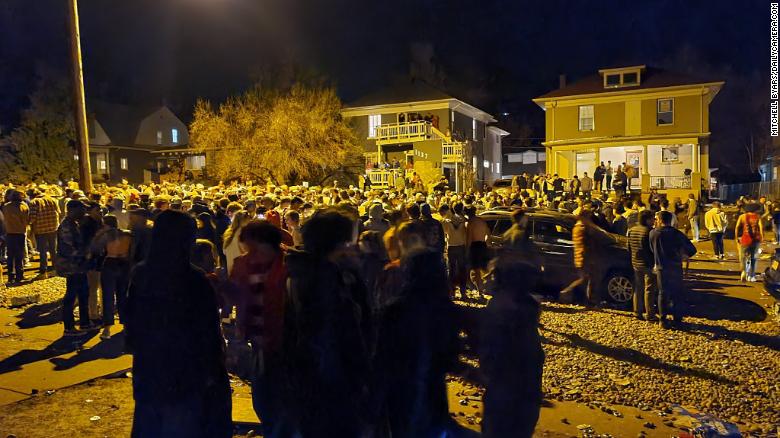Here’s how close the US is to a possible Covid-19 surge, expert warns

The coronavirus pandemic appears to be in decline, but the US is actually in the “eye of the hurricane” right now, according to a leading epidemiologist.
After months of devastation, steep decreases have been reported in Covid-19 cases and hospitalizations. More people are getting vaccinated, and the government on Monday released guidance on safe activities for fully vaccinated people.
But now infection numbers have plateaued at very high levels — with the US averaging 60,000 new cases daily in the past week. Multiple governors have eased safety measures despite health officials’ warnings. Spring break events are kicking off across the country, threatening the potential for further spread of the virus.
Experts project the country is about to see another dangerous Covid-19 spike.
“Let me just say we are in the eye of the hurricane right now,” Michael Osterholm, the director of the Center for Infectious Disease Research and Policy at the University of Minnesota, told NBC’s “Meet the Press” on Sunday.
The spike will be fueled by the B.1.1.7 variant, first spotted in the United Kingdom, and will come over the next six to 14 weeks, Osterholm said.
“Four weeks ago, the B.1.1.7 variant made up about 1 to 4% of the virus that we were seeing in communities across the country. Today, it’s up to 30 to 40%,” he said. “What we’ve seen in Europe, when we hit that 50% mark, you see cases surge,” he said.
Here’s what we know about the B.1.1.7 variant
While there are multiple variants of coronavirus circulating in the US, experts have been particularly concerned with the highly contagious B.1.1.7 variant’s dangerous potential.
In mid-January, the Centers for Disease Control and Prevention warned cases of the variant were likely to see “rapid growth in early 2021,” adding it would likely become the predominant variant in the US by this month.
So far, the agency has reported more than 3,000 known cases of the variant across 47 states, Puerto Rico and Washington, DC. About a quarter of those cases are in Florida. But the CDC has said that likely does not represent the total number of such cases in the US — but rather just the ones that have been found by analyzing positive samples, with the help of genomic sequencing.
Infectious diseases specialist and epidemiologist Dr. Celine Gounder told CNN on Sunday she was on an emergency meeting a group of experts held on Christmas Eve to discuss the variant.
“We’ve been tracking it very closely since then,” she said. “Where it has hit in the UK and now elsewhere in Europe, it has really been catastrophic. It has driven up rates of hospitalizations and deaths and it’s very difficult to control.”
New research shows that in the US, the variant is 59% to 74% more transmissible than the original novel coronavirus. Gounder says cases in the US are “increasing exponentially.”
That’s why it’s crucial for the country to keep pushing to lower Covid-19 infections. Vaccination numbers are still not high enough — and won’t be high enough in several weeks’ time — to help suppress the predicted surge, experts warned.
“This is sort of like we’ve been running this really long marathon, and we’re 100 yards from the finish line and we sit down and we give up,” Gounder said. “We’re almost there, we just need to give ourselves a bit more time to get a larger proportion of the population covered with vaccines.”
‘This is not just about personal choice’
Since the beginning of March, multiple governors announced they were loosening restrictions put in place to help curb the spread of the virus.
On Monday, Wyoming Gov. Mark Gordon announced he is removing the statewide mask requirement and allowing restaurants, bars, theaters and gyms to resume normal operations starting March 16.
Gordon pointed to declining numbers of active Covid-19 cases and hospitalizations, as well as the state’s vaccine rollout, as reasons for the changes.
He urged citizens to “continue to take personal responsibility for their actions and stay diligent,” including by wearing masks indoors and observing requests by private businesses.
Texas Gov. Greg Abbott announced last week he was lifting the statewide mask mandate and would allow businesses to reopen at 100% capacity, starting Wednesday. Mississippi Gov. Tate Reeves made a similar announcement, saying he was doing away with county mask mandates and capacity limits for businesses.
On Sunday, Reeves defended his decision, saying that trying to entirely rid the state of Covid-19 cases would be an unrealistic goal, and the numbers officials were concerned about had all decreased.
“We look much more closely from a data standpoint at hospitalizations, number of Mississippians in the ICU, number of Mississippians on ventilators … all of those numbers have plummeted in our state over the last two months,” he told CNN.
And even without mask mandates, the governor said he recommends and “strongly” encourages residents to wear masks.
Dr. Ashish Jha, dean of the Brown University School of Public Health, told ABC the responsible thing for states to do is to keep mask mandates in place.
“This is not just about personal choice, right, it’s like if I were to drink and get behind the wheel of a car, it’s not just a personal choice that I’d be putting my life at risk, I’d be putting other people’s lives at risk,” Jha said.
“When you wear a mask you’re not just protecting yourself, you’re protecting people around you,” he added.
Less than 10% of Americans fully vaccinated
Health officials say a more appropriate time for states to begin easing restrictions would be when daily Covid-19 cases are way down — “considerably less” than 10,000, according to Dr. Anthony Fauci — and vaccination numbers are way higher.
So far, more than 60 million Americans have received at least one dose of a Covid-19 vaccine, according to CDC vaccination data.
More than 31.2 million have received two doses, the data shows. That’s roughly 9.4% of the US population.
That means more people in the United States have been fully vaccinated against Covid-19 than the 29 million confirmed coronavirus infections the country has seen so far during the pandemic, according to the latest data from the CDC.
But officials are hopeful vaccinations will continue ramping up in the coming months with the help of increased supply.
Andy Slavitt, a senior adviser to the White House Covid-19 response team, said on MSNBC on Sunday there will be more than enough vaccines produced for every adult by the end of May. The President also said last week the US will have enough vaccines for every adult American by the end of May — speeding up the administration’s previous goal by two months.
“We’ll have enough vaccines, I think we said for 300 million Americans,” Slavitt said Sunday. “There’s 250 million adults in the country right now, and right now, as we know, most teenagers are not eligible, and younger kids are not eligible, so it’s more than enough for every adult.”
Slavitt added that vaccines are now going from factories to arms “very, very quickly,” and that the country is getting more efficient at administering the doses.
On Monday, President Joe Biden and Veterans Affairs Secretary Denis McDonough toured the Washington DC VA Medical Center and watched veterans receive their vaccinations.
Biden said that the country is doing “pretty good” at distributing vaccines and said that while the country will reach 100 million doses of vaccine administered soon, officials still need to do a better job of reaching at-risk neighborhoods.
“It’s one thing to have efficiency, and we have to have equity as well,” Biden said.
Guidelines for fully vaccinated people
At the White House COVID-19 Response Team briefing, CDC Director Dr. Rochelle Walensky announced guidelines for safe activities by fully vaccinated people.
Her top points were that those people can:
— Visit other vaccinated people indoors without masks or physical distancing.
— Visit indoors with unvaccinated people from a single family without masks or physical distancing, if the unvaccinated people are at low risk for severe disease.
— Skip quarantine and testing if exposed to someone who has Covid-19 but are asymptomatic (but should monitor for symptoms for 14 days).



